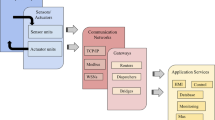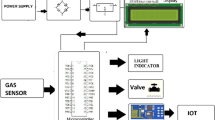Abstract
This paper presents an advanced system for the continuous monitoring of potential threats in a long gas pipeline. For signal acquisition, phase-sensitive optical time domain reflectometry (\(\phi \)-OTDR) technology is employed. Then, pattern recognition strategies are incorporated, which are aimed at identifying threats. To do so, the system integrates a random forest-based approach on top of a multiple-layer perceptron (MLP)-based discriminative approach for feature extraction within a parallel Gaussian Mixture Model (GMM)-Hidden Markov Model (HMM) for pattern classification in a hybrid approach. Subsequently, a system combination strategy, which makes use of the decisions carried out by this hybrid approach, is also presented. This strategy is based on the so-called majority voting technique, which makes use of the output of the classification step from the different feature extraction strategies and the different number of states in the GMM-HMM-based classification. The system is tested on two tasks: (1) Identification of machine and activity, and (2) detection of threats for the pipeline. Compared with our previous system, the results of this advanced system show that the hybrid feature extraction and pattern classification achieve statistically significant improvements for both tasks (i.e., 5% of relative improvement for the machine and activity identification task, 1% of relative improvement in the threat detection rate, and 15% of relative improvement in the false alarm rate for the threat detection task).











Similar content being viewed by others
References
Bai Y, **ng J, **e F et al (2019) Detection and identification of external intrusion signals from 33 km optical fiber sensing system based on deep learning. Opt Fiber Technol 53:102,060:1-102,060:9
Bishop CM (1995) Neural Networks for Pattern Recognition. Oxford University Press
Breiman L (2001) Random forests. Mach Learn 45(1):5–32
Bublin M (2021) Event detection for distributed acoustic sensing: Combining knowledge-based, classical machine learning, and deep learning approaches. Sensors 21(22):7527:1-7527:17
Cao C, Fan XY, Liu QW, et al (2015) Practical pattern recognition system for distributed optical fiber intrusion monitoring system based on phase-sensitive coherent OTDR. In: Proceeding of asia communications and photonics conference, pp 145:1–145:3
Chen J, Wu H, Liu X, et al (2018) A real-time distributed deep learning approach for intelligent event recognition in long distance pipeline monitoring with DOFS. In: Proceeding of international conference on cyber-enabled distributed computing and knowledge discovery (CyberC), pp 290–296
Conway C, Mondanos M (2015) An introduction to fibre optic intelligent distributed acoustic sensing (iDAS) technology for power industry applications. In: Proceeding of international conference on insulated power cables, pp 1–6
European Gas Pipeline Incident Data Group (EGIG) (2008) \(7^{th}\) egig-report on gas pipeline incidents (1970-2007). Tech. rep., European Gas Pipeline Incident Data Group (EGIG), https://www.egig.eu/reports Last access August 2022
FOCUS SL (2015) FIber Network Distributed Acoustic Sensor (FINDAS). http://www.focustech.eu/FINDAS-MR-datasheet.pdf, Last access November 2015
Frank E, Hall MA, Witten IH (2016) The WEKA Workbench. Online Appendix for Data Mining: Practical Machine Learning Tools and Techniques. Morgan Kaufmann, Fourth Edition
Hamadi A, Montarsolo E, Kabalan A, et al (2020) Machine learning based analysis of optical fiber sensing intensity data for train tracking application. In: Proceeding of international conference on optical fiber sensor, pp T3.76:1–T3.76:4
He J, Hu X, Zhang D et al (2021) Semi-supervised learning for optical fiber sensor road intrusion signal detection. Appl Opt 61(6):C65–C72
He Z, Liu Q, Fan X, et al (2018) Fiber-optic distributed acoustic sensors (DAS) and applications in railway perimeter security. In: Proceeding of SPIE 10821 advanced sensor systems and applications VIII, pp 1082,102:1–1082,102:6
Hernandez PD, Ramirez JA, Soto MA (2021) Deep-learning-based earthquake detection for fiber-optic distributed acoustic sensing. J Light Technol 1–12
Huang L, Li Y, Chen S et al (2020) Building safety monitoring based on extreme gradient boosting in distributed optical fiber sensing. Opt Fiber Technol 55:102,149:1-102,149:6
Huang XD, Zhang HJ, Liu K et al (2018) Fully modelling based intrusion discrimination in optical fiber perimeter security system. Opt Fiber Technol 45:64–70
Hussels MT, Chruscicki S, Arndt D et al (2019) Localization of transient events threatening pipeline integrity by fiber-optic distributed acoustic sensing. Sensors 19(15):3322:1-3322:21
Jia H, Liang S, Lou S et al (2019) A k-nearest neighbor algorithm-based near category support vector machine method for event identification of \(\phi \)-OTDR. IEEE Sensors 19(10):3683–3689
Johnson D, et al (2004) ICSI Quicknet software package. http://www.icsi.berkeley.edu/Speech/qn.html, Last Access August 2022
Kowarik S, Hussels MT, Chruscicki S et al (2020) Fiber optic train monitoring with distributed acoustic sensing: Conventional and neural network data analysis. Sensors 20(2):450:1-450:11
Li S, Peng R, Liu Z (2020) A surveillance system for urban buried pipeline subject to third-party threats based on fiber optic sensing and convolutional neural network. Struct Health Monit 1–12
Ma L, Xu T, Cao K et al (2022) Signal activity detection for fiber optic distributed acoustic sensing with adaptive-calculated threshold. Sensors 22(4):1670:1-1670:17
Pan Y, Wen T, Ye W (2022) Time attention analysis method for vibration pattern recognition of distributed optic fiber sensor. Optik 251(168127):168,127:1-168,127:8
Peng Z, Wen H, Jian J et al (2020) Identifcations and classifcations of human locomotion using rayleigh-enhanced distributed fber acoustic sensors with deep neural networks. Sci Rep 10:21,014:1-21,014:11
Pipeline Safety Trust (2004) Nationwide data on reported incidents by pipeline type (gas transmission, gas distribution, hazardous liquid). https://pstrust.org/accident/, Last Access August 2022
Rabiner LR (1987) A tutorial on hidden markov models and selected applications in speech recognition. Proc IEEE 77(2):257–286
Shi Y, Wang Y, Zhao L et al (2019) An event recognition method for \(\phi \)-OTDR sensing system based on deep learning. Sensors 19(15):3421:1-3421:9
Stajanca P, Chruscicki S, Homann T et al (2018) Detection of leak-induced pipeline vibrations using fiber-optic distributed acoustic sensing. Sensors 18(9):2841:1-2841:18
Sun Q, Feng H, Yan X et al (2015) Recognition of a phase-sensitivity OTDR sensing system based on morphologic feature extraction. Sensors 15:15,179-15,197
Tejedor J, Martins HF, Piote D et al (2016) Towards prevention of pipeline integrity threats using a smart fiber optic surveillance system. J Light Technol 34(19):4445–4453
Tejedor J, Macias-Guarasa J, Martins H et al (2017) A novel fiber optic based surveillance system for prevention of pipeline integrity threats. Sensors 17(2):E355:1-E355:19
Tejedor J, Macias-Guarasa J, Martins HF, et al (2018) A Gaussian mixture model-Hidden Markov model (GMM-HMM)-based fiber optic surveillance system for pipeline integrity threat detection. In: Proceeding of international conference on optical fiber sensors
Tejedor J, Macias-Guarasa J, Martins HF et al (2019) A contextual GMM-HMM smart fiber optic surveillance system for pipeline integrity threat detection. J Light Technol 37(18):4514–4522
Tejedor J, Macias-Guarasa J, Martins HF et al (2021) A multi-position approach in a smart fiber-optic surveillance system for pipeline integrity threat detection. Electronics 10(6):712:1-712
Wang X, Zhang G, Lou S et al (2022) Two-round feature selection combining with LightGBM classifier for disturbance event recognition in phase-sensitive OTDR system. Infrared Phys Technol 123(104):191
Wang Z, Zheng H, Li L et al (2019) Practical multi-class event classification approach for distributed vibration sensing using deep dual path network. Opt Express 27(17):23,682-23,692
Wu H, Li X, Peng Z, et al (2014a) A novel intrusion signal processing method for phase-sensitive optical time-domain reflectometry (\(\phi \)-OTDR). In: Proceeding of SPIE, pp 9157O–1–9157O–4
Wu H, Wang Z, Peng F, et al (2014b) Field test of a fully distributed fiber optic intrusion detection system for long-distance security monitoring of national borderline. In: Proceeding of SPIE, pp 915,790–1–915,790–4
Wu H, **ao S, Li X et al (2015) Separation and determination of the disturbing signals in phase-sensitive optical time domain reflectometry (\(\phi \)-OTDR). J Light Technol 33(15):3156–3162
Wu H, Qian Y, Zhang W et al (2017) Feature extraction and identification in distributed optical-fiber vibration sensing system for oil pipeline safety monitoring. Photonic Sensors 7(4):305–310
Wu H, Liu X, **ao Y et al (2019) 1-D CNN based intelligent recognition of vibrations in pipeline monitoring with DAS. J Light Technol 37(17):4359–4366
Wu H, Liu X, **ao Y et al (2019) A dynamic time sequence recognition and knowledge mining method based on the hidden Markov models (HMMs) for pipeline safety monitoring with \(\phi \)-OTDR. J Light Technol 37(19):4991–5000
Wu H, Yang M, Yang S et al (2020) A novel DAS signal recognition method based on spatiotemporal information extraction with 1DCNNs-BiLSTM network. IEEE Access 8:119,448-119,457
Wu H, Yang S, Liu X et al (2021) Simultaneous extraction of multi-scale structural features and the sequential information with an end-to-end mCNN-HMM combined model for fiber distributed acoustic sensor. J Light Technol 39(20):6606–6616
Wu H, Zhou B, Zhu K et al (2021) Pattern recognition in distributed fiber-optic acoustic sensor using an intensity and phase stacked convolutional neural network with data augmentation. Opt Express 29(3):3269–3283
Xu C, Guan J, Bao M et al (2018) Pattern recognition based on time-frequency analysis and convolutional neural networks for vibrational events in \(\phi \)-OTDR. Optical Engineering 57(1):016,103:1-016,103:7
Xu W, Yu F, Liu S et al (2022) Real-time multi-class disturbance detection for \(\phi \)-OTDR based on YOLO algorithm. Sensors 22(5):1994:1-1994:12
Yang M, Wu H, Yang S, et al (2020a) Intelligent identification of vibration for monitoring of the buried optical communication cable in urban with DAS. In: Proceeding of international conference on optical fiber sensor, pp Th4.44:1–Th4.44:4
Yang N, Zhao Y, Chen J (2022) Real-time \(\phi \)-OTDR vibration event recognition based on image target detection. Sensors 22(3):1127:1-1127:23
Yang S, Wu H, Lu H, et al (2020b) Simultaneous structural and sequential information extraction for DAS sensing signals with mCNN-HMM. In: Proceeding of international conference on optical fiber sensor, pp Th4.37:1–Th4.37:4
Zhang M, Li Y, Chen J et al (2019) Event detection method comparison for distributed acoustic sensors using \(\phi \)-OTDR. Optical fiber technology 52:101,980:1-101,980:7
Zhu H, Pan C, Sun X (2014) Vibration pattern recognition and classification in OTDR based distributed optical-fiber vibration sensing system. In: Proceeding of SPIE, pp 906,205–1–906,205–6
Acknowledgements
This work was partially supported by the Ministry of Science, Innovation and Universities of Spain (grant number RTI2018-095324-B-I00). This work was also funded by the Spanish Ministry of Economy and Competitiveness with projects ARTEMISA (TIN2016-80939-R) and HEIMDAL-UAH (TIN2016-75982-C2-1-R), by the Spanish Ministry of Science and Innovation MCIN/AEI/10.13039/501100011033 and by the European Union Next Generation EU/PRTR program, with projects PSI (PLEC2021-007875), ATHENA (PID2020-115995RB-I00) and EYEFUL (PID2020-113118RB-C31), and by CAM and UAH under projects ARGOS+ (PIUAH21/IA-016) and CONDORDIA (CM/JIN/2021-015). The authors gratefully acknowledge the computer resources at Artemisa, funded by the European Union ERDF and Comunitat Valenciana as well as the technical support provided by the Instituto de Fisica Corpuscular, IFIC (CSIC-UV). The authors thank Sira E. Palazuelos-Cagigas for her participation in the writing and technical editing of the manuscript.
Author information
Authors and Affiliations
Corresponding author
Ethics declarations
Competing interests
Authors declare no conflict of interest.
Additional information
Publisher's Note
Springer Nature remains neutral with regard to jurisdictional claims in published maps and institutional affiliations.
Rights and permissions
Springer Nature or its licensor (e.g. a society or other partner) holds exclusive rights to this article under a publishing agreement with the author(s) or other rightsholder(s); author self-archiving of the accepted manuscript version of this article is solely governed by the terms of such publishing agreement and applicable law.
About this article
Cite this article
Tejedor, J., Macias-Guarasa, J., Martins, H.F. et al. A hybrid cascade-parallel discriminative-generative model for pipeline integrity threat detection in a smart fiber optic surveillance system. Multimed Tools Appl (2024). https://doi.org/10.1007/s11042-024-19386-3
Received:
Revised:
Accepted:
Published:
DOI: https://doi.org/10.1007/s11042-024-19386-3




